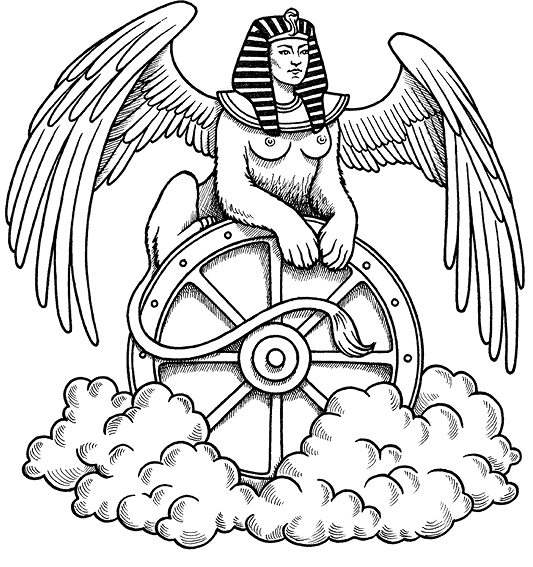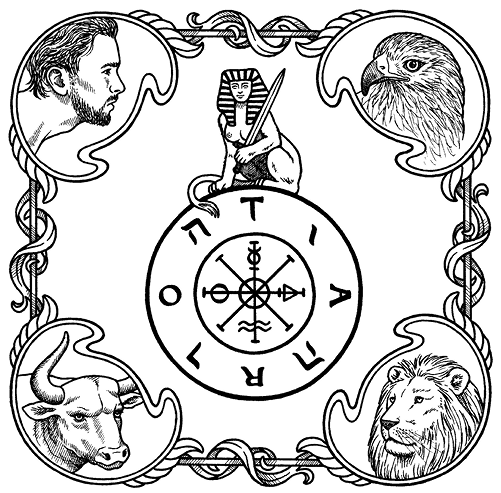
Related in world animistic folklore to the beguiling mystery of our own happiness, the Sphinx protects but also casts down her adjudications upon our lives here on earth. Our Lady of the ROTA is often invisible to the uninitiated eye and is fixed in Jupiter’s cherubic hegemonies, the elemental spirits, of which she is absolutely composed. Proposing the riddle of karma and the dharmic cycles directly ahead of us on the trundle, she observes everything. The Sphinx is the ruling intelligence of the sacred mysteries and the keeper of the secret names of God. Featured masterfully in the Rider-Waite Tarot on Trump X, the Wheel of Fortune, this mythological pictograph of adaptive mastery is every magician’s very
own terrifying and resplendent confidant.
Secret Society Spiritualism
As a symbolic puzzle key of universal order, the Sphinx is faithfully allied with supernatural abilities of keen perception and is patroness of the sacred mystery cults of Egypt. Contemporary ceremonial organizations are filled with the esoteric, linguistic, and mathematical code of the ancient civilizations. The framework of our modern tarot formula relies heavily on the Victorian translations and Gnostic work of secret esoteric societies like the Golden Dawn.
In the 1880s, members of this fraternal occult tradition translated volumes of the world’s most beloved mystical texts. In a spectacle of typical mid-Victorian zeal, they took to the academic study and ritual practice of the corpus of global humanities, binding this work to the starry belt of the zodiac. An intriguing portion of these ceremonial texts included the Kabbalistic rituals and Hebrew studies of Eliphas Levi. His extensive astrological and alchemical work reflected the bohemian math and science advances of Ottoman academia. Levi’s symbolic tables were translated from the Gnostic works of John Dee and Heinrich Cornelius Agrippa. His universal code became essential in the creation of one of the first pictorial decks, the Italian Sola-Busca Tarot.
Commissioned sometime in the late fifteenth century, this Renaissance deck provided the framework for a global obsession with neoclassical art, and certainly explains our modern penchant for the reclaimed mythic symbolism of antiquity. A member of the Golden Dawn, artist Pamela Colman Smith studied and worked on a near-replica Edwardian version, the Rider-Waite Tarot, published in 1910. Smith’s depiction of the nemes-clad Blue Sphinx appeared Technicolor in its own time, and as a pictograph of the ethics of occult philosophy, it remains second to none.
The Nemes and Uraeus
The Sphinx and her traditional headdress, the nemes (pronounced neh-may), were both popularized during the First Dynasty, sometime around 3100 bce, following the unification of the southern dry lands of Upper Egypt with the contrasting northern wetlands of Lower Egypt. The lightweight, loom-woven linens were a common feature of the Nile Delta and were produced in a variety of warp-and-weft patterns. Warp is the lengthwise or longitudinal thread in a roll, while weft is the transverse thread, symbolic of the unseen fabric of reality. Egyptian spirituality prized weavers as cocreators of our world. Artfully pleated to reveal semitransparent repetitions of light and silhouette, this Gnostically woven fabric proved an impressive Copper Age luxury. The nemes (a striped linen headdress) was paired with an uraeus (the sculpted rearing cobra), both bound to the head with finely woven gold cord sacred to Nut and Isis. The snake was a revered form of the goddess Wadjet, patroness of the Nile and wife of Hapi, god of flooding.
When worn together, the uraeus and nemes became a crowning symbol of unity and sovereignty in the Old Kingdom. They were used most notably to shroud a pharaoh legally with the primordial power of creation. The twofold mystical sibling allegories of the Nile civilization are aboriginal to the region. Religious rituals used the nemes in the reenacting of creation and venerated the paradoxical dualism of something from nothing, life from death. Priests and shamans officiated public ceremonies and administered epic celebrations, which kept the living in constant contact with the dead.
The systematic privileges of ordered society, and the regimented administration of shamanic ritual offerings, known only to a few, were outwardly obscured in the hieroglyphic art and richly sculpted architecture of monolithic polytheism. One could say that the mysteries of the cosmos were hidden in plain sight!
A common depiction is the story of creation, illustrating humanity’s rise—out of the waters of life and into our leafy longboats built to fish upon the divine and celestial Nile, a perfect mirror of the heavens. Plants such as flax, papyrus, lotus, and palm that grew naturally along the river all came to symbolize complex esoteric themes of self-discipline, enlightenment, and immortality. Ceremonially woven linen was profoundly connected to the magical spirit of the river. According to the mythology of the Egyptian Book of the Dead, the goddess Neith, using celestial mathematics, secretly wove the first Nile linen cloth; her name bears the hieroglyph for the loom.
Wearing a pharaoh’s headdress equips the Sphinx with the unlimited authority of a deity. It designates her as God’s right hand (the Hand of Fate), thus placing her in a position of active sulfuric alchemical command. She is the volatile and primordial master of chance and willpower. As the keeper of the keys of mastery, she is a capable yet unpredictable patroness, benign until ignited into an explosive and transformative act.
The Sphinx’s nemes is pleated in a style similar to the celebrated Fourth Dynasty Pharaoh Khufu, patron of engineering and the architectural arts. Khufu was the builder of the Great Pyramid of Giza, which was constructed between 2540 and 2560 bce. Many scholars now believe that it was actually his son Khafre who built the Sphinx to further honor and serve his immortal father in the afterlife. Archeologists unearthed wooden longboats hidden for centuries beneath the paws of the monument that were offered for Khufu’s cosmic journey.
The nemes elevated political leaders as gods of truth, innovation, and stability. They were often depicted in hieroglyphic art as living gods on earth, adored as lions amongst men and entombed as cosmological immortals upon death. Egypt later came to idealize funeral ceremony and transfiguration as the foundation of its civilization. The nemes worn by the Sphinx trademarks a guardian of both temple and tomb, imbued with the divine right of adaptive predominance and adorned with fine Nile linen: the regalia of mystic ascension.
Shrouded in Jupiterian Obscurity
The blue, athletic body of the lioness Sphinx reveals her link with the power and prowess of the Roman “King God” Jupiter, whose planetary colors are King Scale sky blue and Queen Scale violet. According to Chic Cicero and Sandra Tabatha Cicero, Sachiel is the ancient Semitic spirit of providence and the archangel of Jupiter, ruler of Thursday. His name means “covering of God,” an idea that is highly applicable to the nemes-clad Sphinx. In the Greek mythos, the Sphinx appeared as Hera’s Aethiopian monster of justice who was brought from the Gulf of Aqaba to Thebes as an eternal punishment for the unscrupulous abduction of young boys. She devoured the delusional, consumed the ignorant, restored the learned, and rewarded the wise.

The Sphinx lived on Theban ignorance until challenged by the plucky Oedipus, as told to us by Sophocles in Oedipus Rex: In a violent rush of wit she asks, “Which creature has one voice and yet becomes four-footed and two-footed and three-footed?” After careful thought, he replies, “Man, who crawls on all fours as a baby, then walks on two feet as an adult, and then uses a walking stick in old age.” Although answering correctly didn’t save Oedipus from his incestuous fate foretold by the Oracle at Delphi, it did free the people of Thebes from the Sphinx, who, as a result of Oedipus’s response, is said to have laid herself upon a high rock and died.
Throughout the Hellenistic occupation of Egypt, Greece continued New Kingdom traditions, which gave rise to many different types of Sphinxes. The Hieracosphinx, for example, was sacred to the cult of Osiris and Horus, and was a figure of wisdom, Egyptian law, and justice. Worshiped by academics and priests alike, the Hieracosphinx was entrusted with dominion over technology on earth and governmental administration. To mark this he was given the head of a falcon.
The Criosphinx, also popular, was a guardian of the cult of Amon. This icon bore the head of a ram and the body of a lion. The lord of truth was a hidden one, and Criosphinx relates to the Berber spirit Jinn who is also closely connected to the Arabic idea of Genie. Jinn, like Amon, is the unseen force ruling over fertility and the wind.
The Anatomy of Life and Everything in It
The Sphinx is an inspirational key and a brilliant tool of learning. When meditated upon, she becomes a guardian of evocative hidden power and teaches all students the humble wisdom of adaptive learning. She is forever whispering in the ears of pupils who dare to explore the ancient mysteries, “Panta rhei ki ouden mani.” (Everything is changing; nothing is stagnant.) And, while full of the beneficent potential of Jupiter, she is paradoxically bound to the primal energy of female Saturn who devours all those who fall short of the mark or who fail to adapt.
When expounding on the nature of Trump X in the Book of Thoth, Aleister Crowley explains, “This card is attributed to the planet Jupiter, ‘the Greater Fortune’ in astrology. It corresponds to the [Hebrew] letter Kaph, which means the palm of the hand, in whose lines, according to another tradition, the fortune of the owner may be read. It would be narrow to think of Jupiter as good fortune; he represents the element of luck. The incalculable factor.”
Kaph is the hand that spins the wheel. It represents the letter K and is traceable in the shape of the Sphinx’s body, mystically eliciting the mechanics of the universe. Typhon, an evil serpentine god, slithers down the Wheel of Fortune’s left-hand side, moving lustfully toward indulgence. Anubis, loyal friend to all and psychopomp god of the underworld, is lifted up by the power of his mercurial nature, energizing the Wheel with truth, the flooding force of effortless inertia. He appears sublimely suspended in a superhuman defiance of earthly law, which only the jackal-headed Anubis is capable of.
Crowley believed the three keepers of the Wheel were evocative of the three forces of circumstance related to the karmic philosophies of the gunas in Hinduism. Within Vedic philosophy, the stages of man correlate to the three virtues of integrity. Tamas he related to the darkness of Typhon, rajas to the energy of Anubis and excitement, and the sattvas to the calm, liberated intelligence of the Sphinx. These principles resemble our own resolution of karma and must be actively brought into a place of balance by the magician using the three magical virtues of all of ceremonial magic: “To will, to know, and to dare to keep the mysteries silent.”
The mysterious Blue Sphinx guards the world and its elements. She sits atop the Wheel like a lapis enigma, levying the ebb and flow of fate by the karmic law of her empirical scimitar. Her indiscriminate detachment is revealed in the placement of her left hand, on the cutting side of a sword’s hilt. She stoically grips the blade, delivered from the lust of the result. And, like all good anthropomorphic monsters of antiquity, she devours the unworthy in her primal parable
of fortune’s infinite mythic riddle of justice. She bestows blessings at the temple entrance but only to the truly deserved; her obscure favor is the route of all earthly success.
In the myths of Assyria and Babylon, the Sphinx’s tail was a great desert serpent who struck down the unworthy, devouring their sins along with them. Her commanding gaze seems to both start and stop time, but it is the code of the ROTA that makes her most beguiling to aspiring mystics.
ROTA
Often capitalized, this magickal rearrangement of the word TARO (which, in its cyclical path, becomes “tarot”), ROTA is also Latin for “wheel.” The occult code of ROTA corresponds to Levi’s alchemical wheel and is metaphorically used to encapsulate the study, practice, and mastery of the codex of Western esoterica. ROTA links the Wheel of Fortune to nature’s own cycles of birth, life, death, and decay. The tarot is full of Hermetic gods, symbols, and ancestral philosophies, some of which may not have been otherwise preserved.
In my own ceremonial work as a devotional priestess, I use the tarot as a concise, modern Pagan holy book. For me the tarot is alive, filled with spirits from our ancient Pagan world, spirits who are also alive. The spirit of Blue Sphinx has been a true companion of my academic and occult studies: she holds the keys to math, science, astrology, and all systems of adaptive, healthy living. When I study, I allow her to engineer my course of research on a subject by asking her to naturally drive my curiosity. Meditating on her helps me to problem-solve and adapt to innovation or failure with equal merit.
The following key is designed to help readers understand each of the cherubic aspects of the Sphinx in relation to the elements and the role they play throughout the tarot. This is in an attempt to show a more complete model of her intricate symbolism. The Sphinx is a universal framework for elemental religious associations, designed to more effectively express the ancient gods of the natural human world—a time of paradisia lost, but a hidden lesson that we have not yet forgotten. The Sphinx peers out from the sands of time, ever embodying and observing the animistic formula of transmutation vital to our pagan understanding of sacred living and immortal dying.

T
Hebrew language: Yod (light)
Animus cherubim: Eagle
Zodiac: Scorpio
Planet: Mars
Element: Fixed water
Incense: Storax/styrax (related to benzoin)
Human body zone: Neck
Stone: Emerald
Sphinx: Nemes
Hindu guna: Sattvas (intelligent balance)
Cabbalistic world: Atziluth (divine and archetypal)
Location on X The Wheel of Fortune: Lower right
Alchemical substance: Mercury
A
Hebrew language: Heh (window)
Animus cherubim: Lion
Zodiac: Leo
Planet: Sun
Element: Fixed fire
Incense: Frankincense
Human body zone: Heart
Stones: Ruby
Sphinx: Blue body
Hindu guna: Rajas (energy)
Cabbalistic world: Briah (archangelic and creative)
Location on X The Wheel of Fortune: Upper right
Alchemical substance: Sulfur
R
Hebrew language: Vau (priest)
Animus cherubim: Man
Zodiac: Aquarius
Planet: Saturn
Element: Fixed air
Incense: Galbanum
Human body zone: Genitals
Stones: Topaz
Sphinx: Serpentine tail
Hindu guna: Tamas (darkness)
Cabbalistic world: Assiah (material and active)
Location on X The Wheel of Fortune: Upper left
Alchemical substance: Azoth
O
Hebrew Language: Heh (window)
Animus cherubim: Bull
Zodiac: Taurus
Planet: Venus
Element: Fixed earth
Incense: Opoponax (related to myrrh)
Human body zone: Genitals
Stones: Topaz
Sphinx: Serpentine tail
Hindu guna: Tamas (darkness)
Cabbalistic world: Assiah (material and active)
Location on X The Wheel of Fortune: Lower left
Alchemical substance: Salt